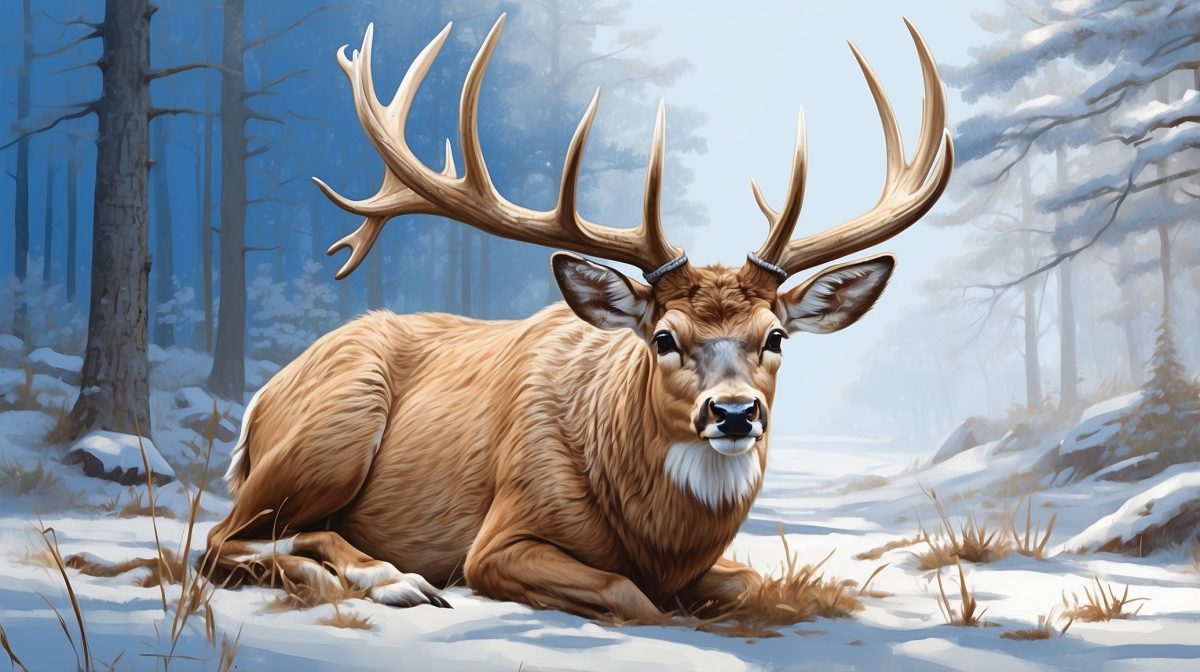The Life Cycle of Whitetail Deer Antlers
Antlerogenesis
Antlerogenesis is the fancy term for the start of antler growth in whitetails, and it’s all about timing and triggers. As the days get longer, the photoperiod—or the amount of daylight—spurs a hormonal response in these deer, kickin’ off the growth of new antlers. It’s a natural cycle that’s as reliable as a sunrise over a Texas prairie.
During this initial phase, hormones like testosterone and insulin-like growth factor play a mighty big role. They’re the catalysts that get those antlers sproutin’, and they work in tandem with the changing seasons to signal it’s time for new growth. It’s a fascinating interplay of nature’s signals that gets the ball rollin’.
Velvet Antlers
Once antlerogenesis has set the stage, we move into the growth phase where things really start to pick up speed. This is when you’ll see those young bucks sportin’ what we call velvet antlers. They’re called that ’cause of the soft, fuzzy covering that’s rich with blood vessels and nutrients. This velvet is crucial, as it’s pumpin’ all the good stuff into the antlers to support their rapid growth.
Now, the purpose of this velvet stage ain’t just to make the antlers look pretty. It’s a critical time when the antlers are growin’ faster than a weed after a spring rain. The deer need a heap of nutrients like calcium, phosphorus, and protein to support this growth, which is why a good diet is as important for them as it is for any athlete in training.
Hardening and Shedding Velvet
As summer wanes and fall whispers its way into the Hill Country, those velvet antlers start to harden. This transition marks the maturation of the antlers from their soft, growing state to the tough, calcified structures we’re more familiar with. It’s a sign that the breeding season, or the rut, is just around the corner, and those bucks will be ready to show off their headgear.
With the hardening of the antlers comes a change in behavior. Bucks become more territorial and start to rub their antlers on trees to strip off the remaining velvet. This ain’t just for show—it’s a way to strengthen their neck muscles and mark their presence, lettin’ other bucks know they’re ready to compete for the ladies.
Shedding and Regeneration
Once the rut is done and the chill of winter sets in, it’s time for the antlers to drop. This seasonal shedding is as natural as the leaves fallin’ from the oaks, and it marks the end of one cycle and the beginning of another. It’s Mother Nature’s way of keepin’ things fresh and givin’ the bucks a rest before they start growin’ a new set of antlers.
The regeneration process is a marvel to behold. After the old antlers have fallen off, the cycle starts anew with the growth of a new set. This regeneration is a testament to the resilience and strength of these animals. It’s a cycle that continues year after year, and it’s as much a part of the Texas landscape as the rolling hills themselves.
Nutritional and Environmental Influences on Antler Growth
The Role of Diet in Antler Development
Just like a good Texas barbecue needs the right ingredients, so do whitetail bucks need the right nutrients for optimum antler growth. Essential nutrients like protein, minerals, and vitamins are the building blocks of a healthy rack. Without ’em, antlers might not reach their full potential.
That’s where supplemental feeding and food plots come in. By providin’ a balanced diet, especially in areas where the natural vittles might be lackin’, we give these deer a leg up. It’s like havin’ a well-stocked pantry—it makes all the difference when it comes to growin’ a set of antlers that are as impressive as a Texas sunset.
Impact of Habitat and Environment
A suitable habitat is as important to a whitetail’s antler growth as a sturdy pair of boots is to a cowboy. Deer need room to roam, access to clean water, and a diverse diet to thrive. Without it, their antler growth can be stunted, just like a plant that’s been stuck in poor soil.
Stress from overcrowding or harsh weather conditions, like a Texas drought, can also put a damper on antler growth. It’s a tough world out there, and when a buck is more worried about survivin’ than thrivin’, his antlers are likely to show it. That’s why a well-managed habitat is key to keepin’ our deer—and their antlers—healthy and strong.
Antler Scoring
Scoring Systems Overview
When it comes to measurin’ the majesty of a buck’s antlers, we’ve got a few different scoring systems to choose from. The Boone and Crockett Club’s system is the gold standard, used for recordin’ the biggest and best antlers across the country. It’s a way to honor those deer that are truly exceptional.
For the bowhunters out there, the Pope and Young Club’s system is tailored to animals taken with archery equipment. Then there’s the Texas Big Game Awards, which gives a local perspective on what makes a truly impressive Texas whitetail. Each system has its own set of rules and standards, but the goal is the same—to recognize the remarkable.
Understanding Scoreable Points
In the world of antler scoring, not all points are created equal. To be scoreable, a point has to meet certain criteria—it’s gotta be at least one inch long and it’s gotta stand out from the main beam. It’s these points that add character to a rack, much like the details on a hand-tooled leather belt.
There’s also the matter of typical versus non-typical racks. Typical antlers have a certain symmetry and standard formation, while non-typical racks are a bit wilder, with points growin’ in all sorts of directions. Both have their own charm and challenges when it comes to scoring.
Measuring and Adding It Up
Scorin’ antlers is a bit like bein’ a tailor—ya need the right tools for the job. A flexible measuring tape and a scoring sheet are the basic tools of the trade. With these in hand, you can measure the length of each tine, the spread of the antlers, and other key features that go into the final score.
The process of scoring antlers is methodical. You start by tallyin’ up the lengths of the main beams, the points, the spread, and the circumferences of the beams. Each measurement is recorded, and then it’s all added up to give you the final score. It’s a step-by-step guide to determinin’ the grandeur of a buck’s crown.
The Significance of Antler Growth and Scoring to Conservation
Antler Growth as an Indicator of Health and Habitat Quality
Antlers are more than just a trophy; they’re a window into the health of our whitetail deer. A buck with a robust set of antlers is often a sign of good nutrition and a healthy habitat. It’s like lookin’ at the leaves of a tree to gauge its overall vigor. When we see deer with strong antlers, we know we’re doin’ somethin’ right in terms of conservation.
There’s also a direct link between antler size and conservation efforts. By monitorin’ the antlers of harvested deer, we can get a sense of the population’s health and make informed decisions about habitat management. It’s a way of listenin’ to what the deer are tellin’ us about their world.
Scoring and Wildlife Management
Scorin’ antlers ain’t just about keepin’ records; it’s a tool for wildlife management. By keepin’ track of the sizes and characteristics of antlers over time, we can assess the effectiveness of our management practices. Are the deer healthy? Is the habitat supportin’ them? These are questions that antler scoring can help answer.
Hunters play a crucial role in conservation, too. By adherin’ to ethical practices and participatin’ in scoring programs, hunters contribute to the data that informs wildlife management. It’s a partnership between man and nature, with the shared goal of ensurin’ that the whitetail deer continue to thrive in Texas Hill Country.
Conclusion
Antler growth and scoring ain’t just for braggin’ rights at the local diner; it’s a window into the health and well-being of our whitetail deer populations here in Texas Hill Country. From the green velvet beginnings to the full glory of a mature buck’s rack, every stage tells a story. And when we score these antlers, we’re not just measurin’ inches; we’re gaugin’ the success of our wildlife management and conservation efforts. So remember, whether you’re out on a guided hunt or just appreciatin’ these creatures from afar, understanding the intricate dance of antler development is key to keepin’ our whitetail deer—and our Texas heritage—thrivin’.
FAQs
What causes some bucks to grow larger antlers than others?
Genetics, nutrition, and overall health are the main factors that determine the size of a buck’s antlers. A healthy diet and a stress-free environment can lead to larger antlers.
Can a whitetail’s antlers give us clues about its age?
While antler size can provide some indication of age, it’s not a foolproof method. Other factors like nutrition and genetics also play a significant role in antler development.
How do environmental factors like drought affect antler growth?
Drought can limit the availability of nutritious food, which can stunt antler growth. Stress from environmental conditions can also negatively impact antler size.
Is there a particular time of year when antler scoring is typically done?
Antler scoring is usually done after the hunting season when bucks have been harvested, and their antlers are fully grown and hardened.
Can antler damage during the velvet stage affect the final score?
Yes, damage during the velvet stage can lead to abnormalities in growth, which may affect the final score of the antlers.


